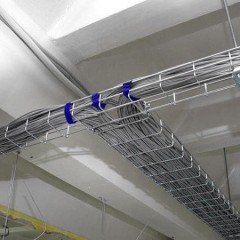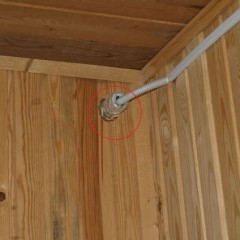Is it possible to lay the cable on the roof of the building according to the PUE
Laying electrical wiring on the roofs of residential and public buildings, on the roofs of entertainment enterprises, in accordance with PUEis not allowed (paragraph 2.1.75). The exception is cases when it comes to power supply to buildings and branches to them. In the rules, it is precisely the wording “with the exception” that applies, from which it follows that the roof can still serve as a place for cable installation when it comes to power supply. However, clause 2.1.75. this does not confirm.
It is recommended (paragraph 2.1.79) to pass the input cable into the building through the wall in the pipe (for more details see: https://our.electricianexp.com/en/kak-provesti-kabel-cherez-stenu.html) As a less desirable option, the roof of the house is used as the power input point. The cable should be in a steel pipe. The rule clause regulates the vertical distance between the roof and the wires. The minimum value of this distance prescribed by the PUE should be 2.5 meters. These conditions exclude the option in which a cable or wire is laid directly on the roof, that is, the roof cannot serve to lay the power line.
An important point! The effect of the specified chapter of the rules is extended to a wire or cable related to power or lighting networks having a voltage of up to 1000 volts of direct or alternating current. Also referred to are secondary circuits. If you are interested in whether it is possible to lay a heating conductor on the roof, the answer is yes, because current regulations are not prohibited. More about roof and gutter heating we told in the corresponding article.
Everything stated in Chapter 2.1 of the EMP refers to electrical wiring made inside a building or structure, on their walls outside. Also, if the wiring is located inside enterprises, institutions, in yards, personal household plots, housing estates, on construction sites using insulated mounting wires of any section. As for the cables, the chapter applies only to those covered with plastic or rubber insulation, not having armor and equipped with a sheath of plastic, rubber or metal, having a phase conductor cross-section of at least 16 mm2.
Thus, an insulated wire of any cross section, as well as a power cable with a cross section of up to 16 mm2 cannot be located on the roof. Roofing is prohibited.
Next we turn to Chapter 2.3 of the EMP. Here are considered valid options for how to run a power cable, the phase conductor cross-section of which exceeds 16 mm2. Descriptions of how to run the cable line are outlined in chapter 2.3. PUEs are as follows:
- In electrical installations of power plants, cables are laid in specially equipped tunnels, ducts, cable channels, blocks, using flyovers and galleries. The roof is not mentioned.
- In electrical installations of consumers - industrial enterprises, the cable is mounted in earthen trenches, also, laying can be done in tunnels, blocks, cable channels. If necessary, cable shelves can be mounted on the walls of buildings for laying cable line fasteners. Galleries and specially built flyovers can also serve for this purpose. Among the options, the roof is also absent.
- Electrical substations and switchgears, as specific energy facilities, are built in accordance with design rules that differ from civil engineering facilities. On the territory of their open switchgears, the cable is most often laid in a tray located on the ground and made of reinforced concrete. In indoor switchgears, the conductor is laid under the floor, where special channels or tunnels are equipped. Flyovers and galleries or laying in earthen trenches can also be used. And here the roof can not be used for cable installation.
- On the territory of cities and towns, earthen laying in trenches predominates. Installation of cable lines in specially equipped collectors and tunnels is allowed. Also, blocks or pipes can be used to lay the electrical network. Roof or roof are not present in the list of options.
- Laying inside buildings can be carried out on building structures, either openly or using pipes. If available, cable floors or shafts are used. Pipes for cable installation can be laid in floors or ceilings, attached to the foundations of equipment. The roof does not appear as the location of the power line.
From the foregoing, it follows that the installation of cables on the roof of an industrial building, as well as a residential building, is not provided for by the Electrical Installation Rules. The foregoing applies to roofs with any type of roof (metal, with a soft roof and others). We hope that now it has become clear to you that laying a cable on the roof of a building is in some cases permissible, but PUE is most often prohibited.
Surely you do not know:







